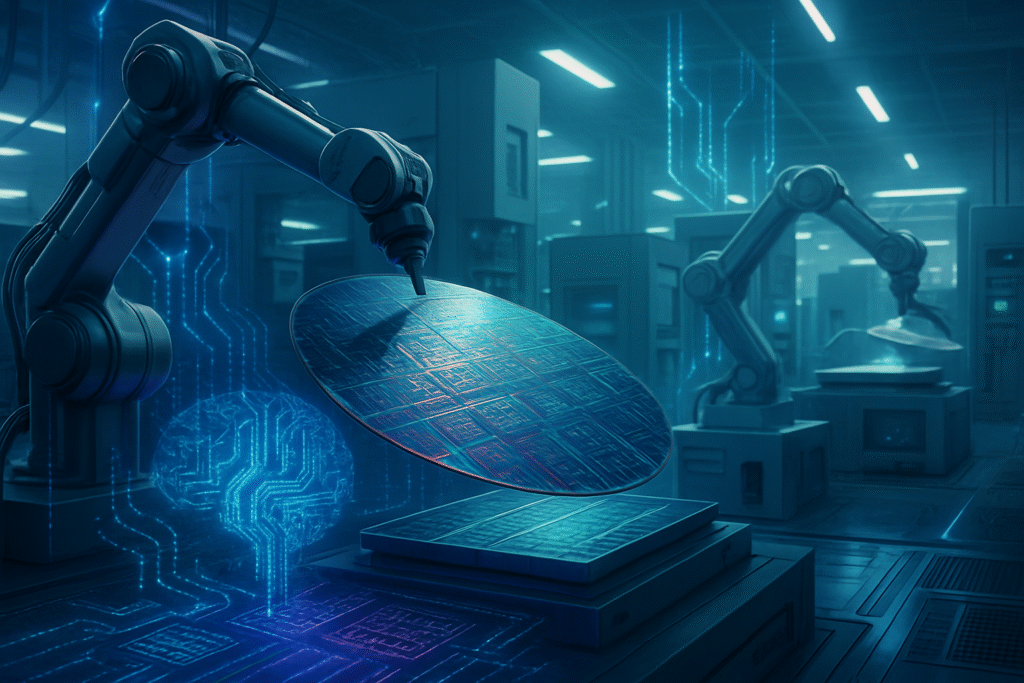
The global semiconductor manufacturing equipment market is experiencing an unprecedented rally, driven by the insatiable demand for advanced chips that power the burgeoning artificial intelligence (AI) revolution. This robust upturn is significantly boosting the financial performance and market valuations of key industry players, reflecting a fundamental shift in the technological landscape. As of early October 2025, companies like KLA Corporation, Applied Materials, ASML, and Lam Research are not only reporting strong earnings but also seeing their stock prices reach new highs, signaling a vibrant and expanding sector critical to the future of AI.
This rally underscores the foundational importance of the semiconductor equipment industry, which provides the intricate machinery and processes necessary to fabricate the cutting-edge processors and memory devices essential for AI. The sustained growth and investment in this sector are not merely a cyclical rebound but rather indicative of a long-term "AI-driven supercycle," where technological advancements in AI are directly fueling demand for more sophisticated and efficient chip manufacturing capabilities. The immediate significance lies in the fact that without this advanced equipment, the ambitious goals of AI development—from large language models to autonomous systems—would remain largely theoretical.
Engineering the Future of Intelligence: Technical Foundations of the Rally
The current surge in the semiconductor manufacturing equipment market is deeply rooted in the complex technical demands of modern AI. At the heart of this demand are specialized chips like High-Bandwidth Memory (HBM) and advanced Graphics Processing Units (GPUs), which require state-of-the-art manufacturing processes to achieve their unprecedented performance. Equipment manufacturers are at the forefront of enabling these innovations.
Companies like ASML (AMS:ASML), with its near-monopoly on Extreme Ultraviolet (EUV) lithography, are indispensable. EUV technology allows chipmakers to print incredibly fine circuit patterns, enabling the creation of chips with billions of transistors on ever-smaller nodes—down to 3nm and beyond. This precision is critical for packing the immense computational power required by AI accelerators. Similarly, KLA Corporation (NASDAQ: KLAC) provides advanced process control and inspection systems, ensuring the quality and yield of these highly complex chips, which is paramount given their intricate designs and high production costs. Applied Materials (NASDAQ: AMAT) and Lam Research (NASDAQ: LRCX) contribute with sophisticated deposition, etching, and other wafer fabrication equipment, crucial for building the multi-layered structures of advanced logic and memory chips, including the stacking techniques used in HBM. These technical capabilities represent a significant leap from previous manufacturing approaches, which struggled with the scaling challenges and material complexities now routinely handled by this advanced equipment.
The AI research community and industry experts have largely welcomed these advancements, recognizing them as essential enablers for next-generation AI. The recent announcement of a significant deal between Advanced Micro Devices (NASDAQ: AMD) and OpenAI, as well as OpenAI's 'Stargate' AI infrastructure project involving SK Hynix (KRX:000660) and Samsung (KRX:005930), highlights the direct link between AI development and the demand for advanced manufacturing. These partnerships signal a future where the ability to produce high volumes of cutting-edge chips quickly will be a major differentiator in the global AI race, making the equipment sector's health a direct indicator of AI's future trajectory.
Reshaping the AI Ecosystem: Corporate Beneficiaries and Competitive Dynamics
The robust rally in the semiconductor manufacturing equipment market has profound implications for the broader AI ecosystem, creating a ripple effect that benefits a wide array of companies, from chip designers to cloud providers. At the forefront are the major AI chip developers such as NVIDIA (NASDAQ: NVDA), Advanced Micro Devices (NASDAQ: AMD), and Intel (NASDAQ: INTC), who rely entirely on the advanced capabilities offered by this equipment to produce their next-generation AI accelerators. The increased capacity and technological sophistication of equipment manufacturers directly translate into more powerful, efficient, and cost-effective AI hardware for these companies.
Hyperscale cloud providers and tech giants like Microsoft (NASDAQ: MSFT), Google (NASDAQ: GOOGL), Amazon (NASDAQ: AMZN), and Meta Platforms (NASDAQ: META) are also significant beneficiaries. As they invest billions in building out their AI infrastructure, the availability of cutting-edge manufacturing equipment ensures a steady supply of the chips needed to power their data centers and AI services. This competitive advantage allows them to offer more robust AI platforms, attract top AI talent, and accelerate their own AI research and product development. Startups in the AI space, particularly those focused on hardware or specialized AI applications, also benefit from the improved access to advanced chips, albeit indirectly, as the overall supply chain becomes more capable.
The competitive landscape among major AI labs and tech companies is intensely influenced by this rally. Companies with strong partnerships with leading foundries and access to the latest manufacturing technologies will be better positioned to innovate and deploy AI solutions at scale. This could potentially disrupt existing products or services that rely on older chip architectures, pushing companies to rapidly adopt newer, more efficient hardware. Market positioning and strategic advantages are increasingly tied to a company's ability to leverage the most advanced semiconductor technologies, making the health of the equipment sector a critical barometer for the entire AI industry.
Broader Significance: Fueling the AI Revolution and Geopolitical Tensions
The rally in the semiconductor manufacturing equipment market is not just a financial story; it's a critical component of the broader AI landscape and a powerful indicator of global technological trends. This sustained growth underpins the entire AI revolution, providing the essential infrastructure for advancements in machine learning, deep learning, and generative AI. Without the continuous innovation in chip manufacturing, the ambitious goals of AI—from developing human-level intelligence to solving grand societal challenges—would be severely constrained.
The impacts extend beyond technology. Economically, the rally signifies massive investments in R&D, job creation, and the strengthening of global supply chains, though it also highlights dependencies. Geopolitically, the strategic importance of semiconductor manufacturing equipment has never been clearer. Nations are increasingly vying for self-sufficiency and control over this critical technology, as evidenced by initiatives like the U.S. CHIPS and Science Act, which aims to bolster domestic manufacturing capabilities. This focus on domestic production, while fostering resilience, can also exacerbate international trade tensions and create complex global dynamics. Potential concerns include the escalating cost of building and maintaining these advanced fabs, which could lead to further consolidation in the industry and create barriers to entry for new players. The environmental impact of increased manufacturing, particularly regarding energy consumption and waste, also remains a significant consideration.
This period of growth in semiconductor equipment can be compared to previous technological milestones, such as the internet boom or the advent of mobile computing. Just as those eras required foundational infrastructure to proliferate, the AI era is fundamentally dependent on advanced silicon. The current rally signals a deep and sustained commitment to building the physical bedrock upon which future AI innovations will stand, making it a defining moment in the history of artificial intelligence.
The Road Ahead: Anticipating Future Developments and Addressing Challenges
Looking ahead, the semiconductor manufacturing equipment market is poised for continued evolution, driven by the relentless pursuit of more powerful and efficient AI. Near-term developments are expected to focus on further refinement of existing technologies, such as pushing EUV lithography to even finer resolutions (High-NA EUV) and developing novel materials for chip fabrication. Long-term, we can anticipate breakthroughs in areas like advanced packaging (e.g., chiplets, 3D stacking) and entirely new computing paradigms, such as neuromorphic computing, which will necessitate entirely new types of manufacturing equipment.
Potential applications and use cases on the horizon are vast. Beyond current AI applications, advanced chips enabled by this equipment will power truly autonomous vehicles, sophisticated medical diagnostics, personalized medicine, advanced robotics, and immersive virtual and augmented reality experiences. The push for edge AI will also drive demand for specialized, low-power chips that can perform AI tasks locally, away from the cloud. However, significant challenges remain. The escalating costs of R&D and fab construction pose a financial hurdle, requiring massive capital investments. The complexity of designing and manufacturing these advanced chips also means a shortage of skilled talent could become a bottleneck. Geopolitical stability and fair trade practices are also critical for maintaining a healthy global supply chain.
Experts predict that the AI-driven supercycle will continue for several years, with sustained demand for advanced manufacturing capabilities. The emphasis will shift towards optimizing power efficiency, integrating more diverse functionalities onto a single chip, and exploring new architectures that can handle the exponentially growing computational demands of AI. What comes next will be a fascinating interplay between materials science, physics, and advanced engineering, all converging to build the next generation of intelligent machines.
A New Era of Silicon: The Enduring Significance of the Equipment Rally
In summary, the current rally in the semiconductor manufacturing equipment market represents far more than a fleeting economic trend; it is a profound indicator of the foundational investments being made to power the artificial intelligence revolution. The impressive stock performance of companies like KLA Corporation (NASDAQ: KLAC), Applied Materials (NASDAQ: AMAT), ASML (AMS:ASML), and Lam Research (NASDAQ: LRCX) reflects their indispensable role in fabricating the advanced chips that are the lifeblood of modern AI. Key takeaways include the direct link between AI demand and equipment sales, the critical role of technological advancements like EUV lithography, and the widespread impact across the entire tech ecosystem.
This development holds immense significance in AI history, marking a period where the physical infrastructure for artificial intelligence is being built out at an unprecedented scale and pace. It underscores that the advancements we see in AI software are inextricably linked to the capabilities of the underlying hardware, which in turn depends on the sophistication of manufacturing equipment. The long-term impact will be a world increasingly shaped by AI, with its capabilities continually expanding as chip technology evolves.
In the coming weeks and months, industry watchers should closely monitor capital expenditure announcements from major chipmakers, further partnerships between AI developers and foundries, and any policy shifts related to semiconductor manufacturing. The sustained health and innovation within the semiconductor manufacturing equipment sector will remain a crucial bellwether for the trajectory and ultimate potential of artificial intelligence globally.
This content is intended for informational purposes only and represents analysis of current AI developments.
TokenRing AI delivers enterprise-grade solutions for multi-agent AI workflow orchestration, AI-powered development tools, and seamless remote collaboration platforms.
For more information, visit https://www.tokenring.ai/.





